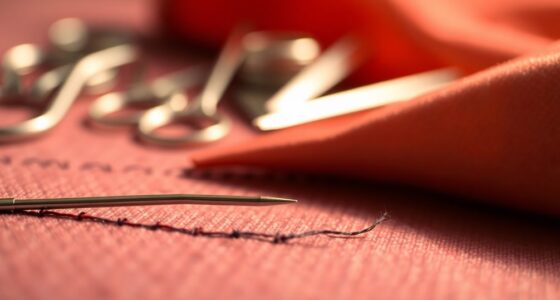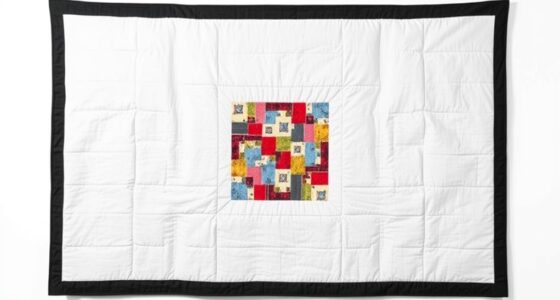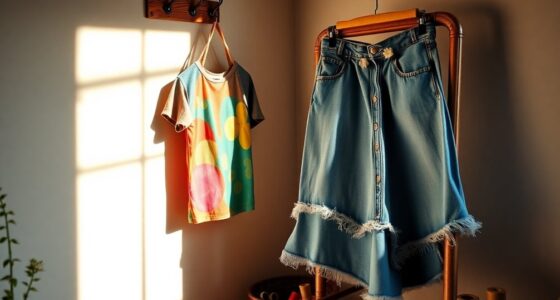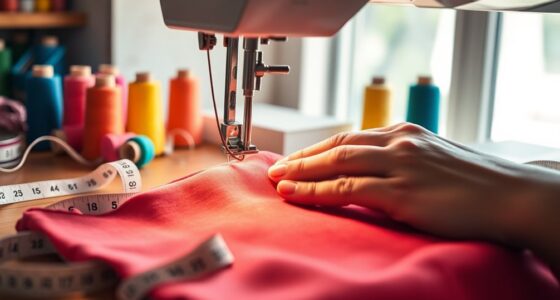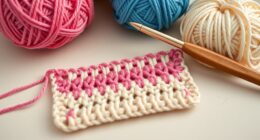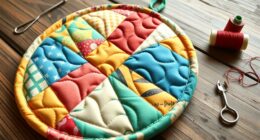To sew buttonholes with a machine, first select the appropriate style and adjust your stitch width and length according to fabric and button size. Test on scrap fabric to guarantee proper settings. Sew slowly, guiding the fabric gently, and use manual override if needed. Troubleshoot issues like skipped stitches by checking tension, thread, and needle condition. Proper setup and maintenance will give you clean, professional buttonholes—keep going to discover more tips for flawless results.
Key Takeaways
- Select the correct buttonhole style and adjust stitch width and length based on fabric and button size.
- Prepare the machine by threading correctly, inserting a sharp needle, and testing on scrap fabric.
- Keep fabric flat and guide it gently through the machine, using manual override for size or shape adjustments.
- Troubleshoot irregular stitches by checking tension, re-threading, or replacing the needle if needed.
- Regularly clean and maintain the machine to prevent issues like skipped stitches or uneven buttonholes.
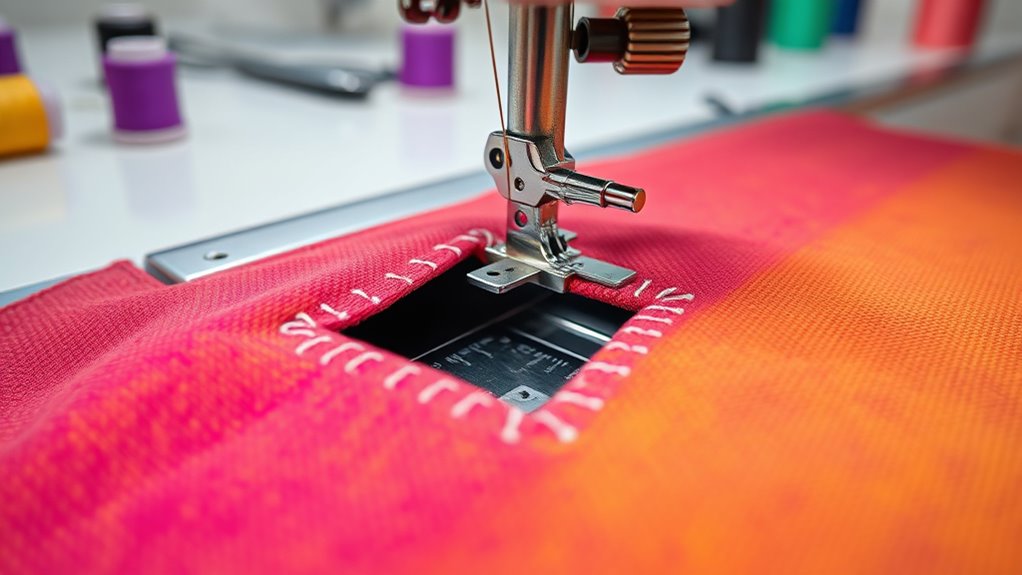
Sewing buttonholes by machine offers a fast and reliable way to finish garments, saving you time compared to hand-sewing. Whether you’re working on a shirt, a jacket, or a pair of trousers, understanding the different types of buttonholes can help you choose the best style for your project. For example, keyhole buttonholes are ideal for lightweight fabrics, while bartack or reinforced buttonholes suit heavier materials. Most modern sewing machines come with built-in buttonhole functions that can accommodate these styles, making the process straightforward once you get the hang of it. However, to keep your machine performing at its best and ensure perfect buttonholes each time, regular machine maintenance is essential. This includes cleaning out lint, checking the bobbin and needle, and lubricating moving parts as specified in your machine’s manual. Proper maintenance prevents skipped stitches, uneven buttonholes, and other common issues, so your machine remains reliable and easy to use.
When you’re ready to sew, start by selecting the appropriate buttonhole style on your machine. Adjust the stitch width and length according to the fabric thickness and the size of the button. Always test on scrap fabric first to verify your settings and ensure your machine is functioning properly. Before beginning, make sure your needle is sharp and correctly inserted; a dull or bent needle can cause uneven stitches or skipped stitches. Also, check that your bobbin is wound correctly and inserted properly, as this influences the tension and overall stitch quality. During sewing, keep the fabric flat and steady, guiding it gently without pulling, to prevent puckering or misalignment. If your machine has a manual override or custom settings, use them to fine-tune the buttonhole size and shape.
As you sew, pay attention to your machine’s response. If you notice irregular stitching, stop and troubleshoot. Common issues include thread jams, tension problems, or a dull needle. Adjust the tension settings, re-thread the machine, or change the needle as needed. After finishing each buttonhole, test it by inserting a button to confirm fit. If it’s too tight or loose, adjust your machine’s settings and try again. Maintaining your machine regularly, especially after frequent use, keeps it running smoothly and prevents problems during your projects. With practice and proper care, sewing buttonholes by machine becomes a quick, efficient process that gives your garments a professional finish.
Frequently Asked Questions
Can I Sew Buttonholes on All Fabric Types?
You can sew buttonholes on many fabric types, but fabric stretch and buttonhole design matter. Stretchy fabrics like knits may need stabilizers or special settings to prevent puckering. For delicate or thick fabrics, choose the right buttonhole style and adjust your machine’s tension. Testing on scrap fabric first helps you determine the best approach, ensuring a neat buttonhole regardless of fabric type.
What if My Buttonhole Stitches Are Uneven?
Imagine your fabric as a calm lake, but uneven buttonhole stitches create ripples that disturb the surface. To fix this, first check your buttonhole thread tension, ensuring it’s even on both sides. Using a fabric stabilizer can also help keep the fabric steady. Adjust your machine’s stitch length and width if needed. With these tweaks, your stitches will become smooth, even ripples across the fabric’s surface.
How Do I Adjust the Buttonhole Size?
To adjust the buttonhole size, start by changing your machine’s settings for buttonhole length. Increase or decrease the length to make the buttonhole longer or shorter as needed. Keep in mind, fabric stretch can influence the size, so select a stabilizer if your fabric is stretchy. Test on scrap fabric first, then fine-tune the length to ensure it fits your buttons perfectly.
Can I Create Decorative Buttonholes?
Yes, you can create decorative buttonholes using decorative stitches and unique buttonhole patterns. Many sewing machines offer specialized options for making decorative buttonholes that add flair to your projects. Experiment with different stitch styles, such as zigzag or satin, and explore various patterns to achieve a personalized, stylish look. Just confirm your machine supports decorative buttonholes, and practice on scrap fabric before working on your final piece.
What Maintenance Is Needed for the Sewing Machine?
You need to regularly maintain your sewing machine for smooth operation. Make sure to oil the machine according to the manufacturer’s instructions to keep its parts moving freely. Replace the needle whenever it becomes dull or bent to ensure clean buttonholes and prevent fabric damage. Additionally, clean out lint and dust from the bobbin area and feed dogs. Proper maintenance keeps your machine running efficiently and extends its lifespan.
Conclusion
Now that you know how to sew buttonholes by machine, you’re all set to tackle this task with confidence. Remember, practice makes perfect, and even the best seamstresses had to start somewhere. Don’t be discouraged by small mistakes—they’re just stepping stones to mastery. As the saying goes, “Every expert was once a beginner,” so keep sewing and refining your skills. Before long, buttonholes will be second nature!

